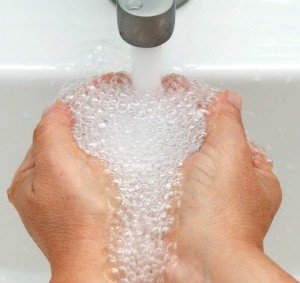 Germs and bacteria of all types, sizes and smells have taken silent resident in your kitchen, the very place where you prepare your food and serve your dinner.
Germs and bacteria of all types, sizes and smells have taken silent resident in your kitchen, the very place where you prepare your food and serve your dinner.
They have a nasty habit of hiding in all the common cracks and crevices of the most social area of your home.
So it’s no surprise that your countertop, fridge, pantry, and dinner table harbors an excellent breeding ground for bacteria and germs that can make you sick.
So what do you suppose is the most prominent place where these nasty germs can hide and then enter your kitchen. Most may be surprised that it’s your hands. The problem, according to health experts, claims that germs are transferred from your own hands, and then transmits from there. So when it comes to the stopping of the spreading of these germs, begin by completely sanitizing your hands first.
A kitchen area which is germ and bacteria free begins with basic hand cleansing. So make sure at all times you scrub them clean with anti-bacterial warm soapy water, or dish soap, before you begin any type of food preparation. Most will even recommend that you also wash between the handling of the different food types.
For instance, after you chop up the chicken, and then get it baking in the oven, make sure that you lather up before you begin chopping up the vegetables.
Once your hands are sanitized, then begin to tidy up the other potential areas where germs can lurk in the kitchen. Just keep in mind the general rule, which is constantly wash your hands, which will kill off the majority of germs and bacteria on contact from spreading.
Cleaning The Cutting Board
There’s usually just one multipurpose cutting board in the kitchen, and as a result, it can become a breeding ground for collecting a variety of germs in the grooves, and on the surface.
So it becomes extremely important that you thoroughly scrub your cutting board, this after each and every use, otherwise, cross contamination can occur.
Make sure that you sterilize all your wooden cutting boards with hot soapy water, and replace it once they begin to get deep gouges in them. If the cutting board happens to be plastic, run it through the dishwasher after each use, especially between different food types.
You might also consider multiple cutting boards, and dedicate one for meat and poultry prep, another for fruit and vegetables, this to avoid the contamination of the produce, especially if you’re not planning to cook them.
The Kitchen Countertop
Before you prepare any food, as well as immediately after, make sure that you clean your countertops with hot soapy water. Use clean absorbent paper towels to clean up any of the messy spills, especially any leakage from poultry, meat, or fish.
As an alternate to soap and hot water, you can try using a thyme-based antiseptic cleaner which is botanical based. This way, there’s no harmful chemical disinfectants which can potentially contaminate the food.
What’s Living In Your Kitchen Sink
A recent study found that kitchen sinks can host the most variants of germs and bacteria, even more than both the typical garbage can or toilet bowl. So to be safe, always perform an effective sink scrub before preparing any meal.
It’s suggested that you mix together liquid dish soap with baking soda for a thorough cleansing, this to eliminate any germs which can transfer on the food. Another rule is keeping any foods which you eat raw, such as fruits and vegetables, from even touching the inside of the sink.
Cleaning The Inside Of Your Fridge
The shelves as well as the drawers can easily become contaminated over time, especially since food packages will leak and remain on the shelf. If anything does happen to spill, drip, or leak, make sure that you wipe it up immediately.
If your fridge happens to have a water dispenser mounted on the outside, make sure that you scrub the tray which catches the runoff clean on a daily basis. This is the perfect place for bacteria and mold to flourish and contaminate on your hands.
It’s also recommended that you monitor the exterior seal of the fridge, which can also get moldy. This can especially occur during the summer, when the inside of your fridge is cold, and the exterior is hot and humid.
Dirty Dish Rags And Cleaning Sponges
Where bacteria likes to thrive and grow is in damp dark places. So that means every damp towel or rag, sponge, and dish cloth, are perfect areas for the growth and spreading of germs.
They can however be easy to sanitize. Make sure that you completely wring them out by squeezing them really well after use. You can also boil them on the stove top, then dry them in the microwave. Another option is placing the sponges in the dishwasher, which will effectively kill the bacteria.
All Handles And Knobs Collect Germs
Think of all of the knobs and handles which are in your kitchen, bathroom, and dining area. This includes your fridge, dishwasher, toaster, oven, microwave, and faucets.
These surfaces will get the most “hand-to-hand” contact and get contaminated, this especially during the food preparation process. These are also areas where you usually don’t bother wiping down on a regular basis.
So once you wipe down and sanitize the counter tops at the end of the meal, or once the dishes are washed, make sure that you use a warm soapy sponge, or use a clean paper towel, and wipe clean all the handles and knobs in your kitchen. This to eliminate all of the accumulated germs and bacteria collected during the day.
